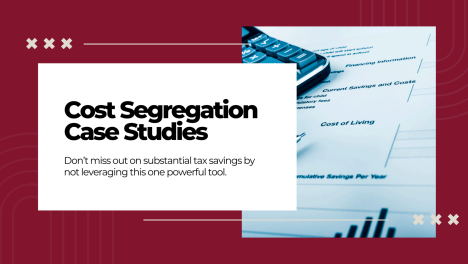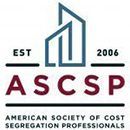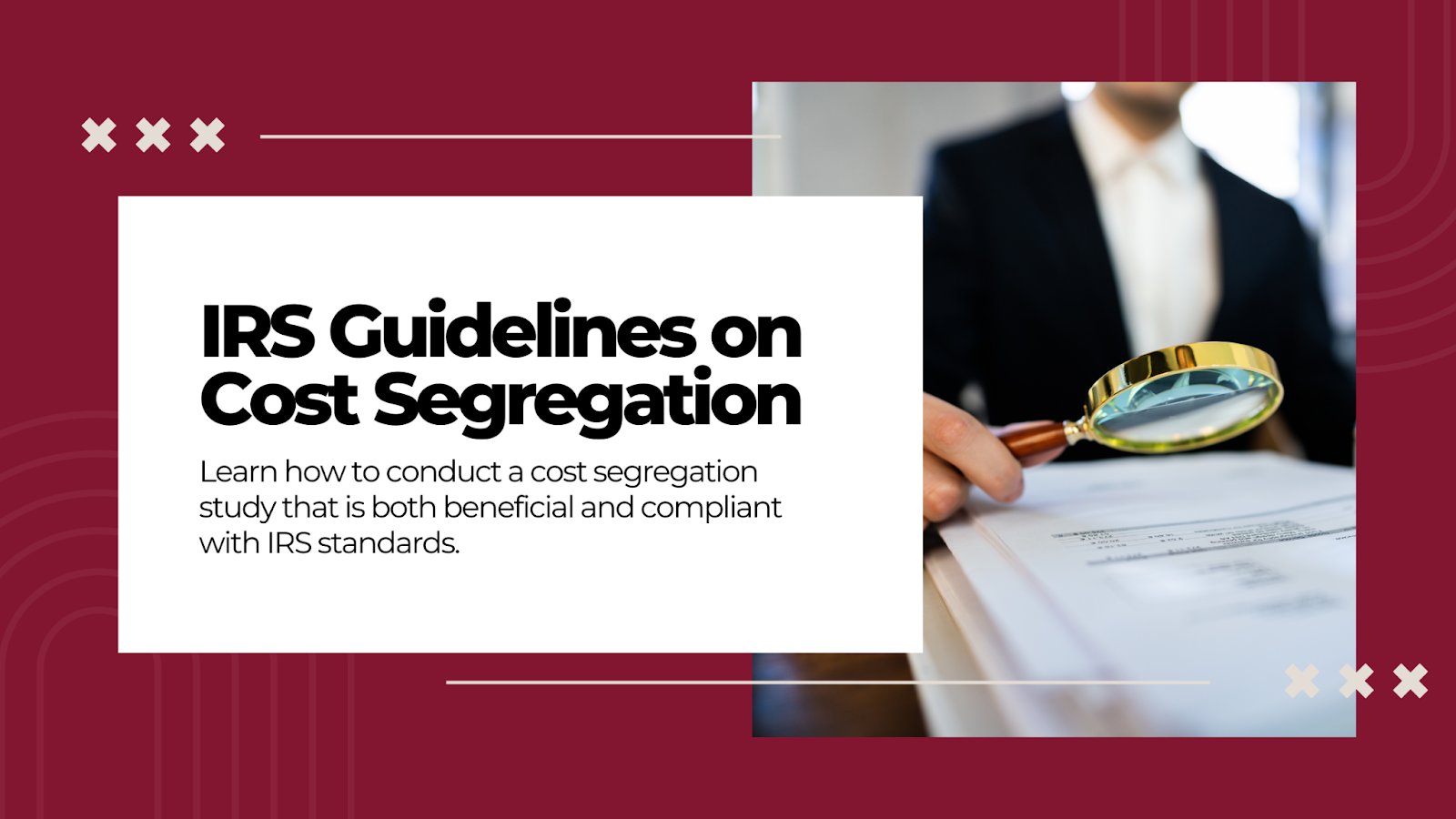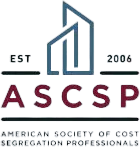Cost Segregation Case Studies

Are you leaving money on the table with your real estate investments? Many investors unknowingly miss out on substantial tax savings by not leveraging one powerful tool: cost segregation.
Maximizing tax savings is a crucial aspect of real estate investment success. Every dollar saved can be reinvested, improving cash flow and overall return on investment. For property owners and investors, understanding and utilizing advanced tax strategies can make a significant difference in financial outcomes.
Cost segregation is a tax planning strategy that allows property owners to accelerate depreciation deductions, resulting in increased cash flow and reduced tax liability. By reclassifying certain building components and improvements, investors can optimize their tax benefits. In this blog, we'll discuss several cost segregation case studies on various types of properties. From residential to commercial and industrial properties, these examples will illustrate how cost segregation can unlock hidden value and maximize your tax savings.
Case Study 1: Residential Property
Property Description
A luxury apartment complex located in a bustling urban area underwent a cost segregation study. The complex, consisting of 100 units, was acquired for $10 million. The property features modern amenities, including a fitness center, a swimming pool, and a rooftop lounge, making it a high-value asset for the investors.
Initial Situation
Before the cost segregation study, the property was placed on a standard 27.5-year depreciation schedule, as per IRS guidelines for residential rental properties. The initial annual depreciation expense was approximately $363,636. This method, while straightforward, did not fully capitalize on the tax savings potential inherent in the property’s diverse components.
The Process
- Engagement and Planning: The property owners engaged a cost segregation specialist to perform a comprehensive study. The process began with an initial consultation and data collection, including architectural drawings, construction invoices, and financial records.
- Site Visit and Inspection: A team of engineers and tax experts conducted a thorough on-site inspection to identify and categorize all property components.
- Component Classification: The team reclassified building components into shorter-lived categories, such as 5-year, 7-year, and 15-year property. Items such as appliances, carpeting, landscaping, and certain structural elements were identified for accelerated depreciation.
- Report Generation: A detailed report was prepared, documenting the findings and reclassification. The report was then reviewed and approved by the property owners' tax advisor.
Results
The cost segregation study resulted in a significant reallocation of the property’s basis. Approximately 20% of the total purchase price was reclassified into 5-year and 15-year property categories. This reclassification increased the first-year depreciation expense to $1.5 million, a substantial increase from the initial $363,636.
Tax Savings and ROI
- Immediate Tax Savings: The accelerated depreciation schedule provided an immediate tax deduction increase of over $1.1 million in the first year alone.
- Cash Flow Improvement: The tax savings translated into a direct improvement in the property’s cash flow, providing additional funds for reinvestment or operational expenses.
- ROI: The return on investment for the cost segregation study was exceptional. The study, which cost $15,000, resulted in a first-year tax saving of $1.1 million, yielding an ROI of over 7000%.
Case Study 2: Commercial Property
Property Description
A mid-sized office building in a thriving business district underwent a cost segregation study. The property, valued at $15 million, includes multiple floors of office space, conference rooms, a cafeteria, and underground parking. The building's prime location and high occupancy rate make it a valuable asset for its investors.
Initial Situation
Initially, the office building was depreciated on a standard 39-year schedule for commercial properties, resulting in an annual depreciation expense of approximately $384,615. This straight-line method, while compliant with IRS regulations, did not take advantage of the potential tax savings available through a detailed cost segregation analysis.
The Process
- Engagement and Planning: The property owners engaged a cost segregation firm to conduct the study. The process began with a thorough review of the building's purchase documentation, architectural plans, and financial records.
- Site Visit and Inspection: A team of engineers and tax professionals conducted an on-site inspection to identify and categorize various components of the building.
- Component Classification: The team reclassified components into shorter-lived categories such as 5-year, 7-year, and 15-year property. Items such as electrical systems, plumbing fixtures, carpeting, specialty lighting, and landscaping were identified for accelerated depreciation.
- Report Generation: A comprehensive report was generated, detailing the reclassification and the new depreciation schedules. This report was reviewed by the property owners' tax advisors for accuracy and compliance.
Results
The cost segregation study led to the reclassification of approximately 25% of the property's basis into shorter-lived asset categories. This reclassification significantly increased the annual depreciation expense for the first few years.
Tax Savings and ROI
- Immediate Tax Savings: The reallocation allowed for an increased first-year depreciation expense of approximately $3 million, up from the initial $384,615.
- Cash Flow Improvement: The increased depreciation deductions resulted in substantial tax savings, enhancing the property's cash flow and providing more funds for business operations and reinvestment.
- ROI: The cost of the cost segregation study was $20,000. The first-year tax savings amounted to $2.6 million, resulting in an ROI of over 13000%.
Case Study 3: Industrial Property
Property Description
An expansive manufacturing facility located in an industrial park underwent a cost segregation study. The property, valued at $25 million, comprises multiple production lines, storage areas, office space, and specialized installations for heavy machinery. This facility is essential for the company's manufacturing operations, making it a high-value asset.
Initial Situation
Initially, the manufacturing facility was depreciated on a standard 39-year schedule, in line with IRS guidelines for industrial properties. This resulted in an annual depreciation expense of approximately $641,025. The straight-line depreciation method, while compliant, did not fully leverage the tax-saving opportunities available through cost segregation.
The Process
- Engagement and Planning: The property owners engaged a specialized cost segregation firm to conduct the study. The process began with a comprehensive review of the facility's purchase documents, blueprints, and financial records.
- Site Visit and Inspection: A team of engineers and tax experts conducted an on-site inspection, meticulously identifying and categorizing various components of the facility.
- Component Classification: The team reclassified numerous components into shorter-lived categories, such as 5-year, 7-year, and 15-year property. Items identified for accelerated depreciation included electrical systems, HVAC units, flooring, specialty plumbing, and various machinery installations.
- Report Generation: A detailed report was generated, outlining the reclassification and new depreciation schedules. This report was reviewed and approved by the property owners' tax advisors to ensure accuracy and compliance.
Results
The cost segregation study resulted in the reclassification of approximately 30% of the property's basis into shorter-lived asset categories. This significantly increased the depreciation expense for the initial years.
Tax Savings and ROI
- Immediate Tax Savings: The reallocation allowed for an increased first-year depreciation expense of approximately $5 million, up from the initial $641,025.
- Cash Flow Improvement: The accelerated depreciation deductions led to substantial tax savings, greatly enhancing the facility’s cash flow and providing additional funds for operational improvements and expansion.
- ROI: The cost of the cost segregation study was $30,000. The first-year tax savings amounted to $4.4 million, resulting in an ROI of over 14600%.
Common Misconceptions and Challenges
Cost Segregation Myths Debunked
- Cost Segregation is Only for Large Properties: While large properties can indeed benefit significantly from cost segregation, smaller properties can also see substantial tax savings. Even modestly valued properties can justify the cost of a cost segregation study through the accelerated depreciation benefits they unlock.
- Cost Segregation is Only for New Properties: Cost segregation can be applied to both new and existing properties. Owners of older properties can perform a retroactive cost segregation study to catch up on missed depreciation deductions and realize tax savings on prior years' tax returns.
- The Process is Too Complex and Expensive: While cost segregation studies do require a detailed analysis, they are conducted by experienced professionals who handle the complexity. The cost of the study is typically outweighed by the tax savings, often resulting in a high return on investment.
- It Raises Red Flags with the IRS: When conducted by qualified professionals following IRS guidelines, cost segregation studies are a legitimate tax strategy and do not inherently raise audit risks. Proper documentation and a thorough, compliant process are key to avoiding issues.
Cost Segregation Challenges
- Accurate Component Identification: Identifying and accurately categorizing all components of a property can be complex, especially in properties with intricate designs or specialized installations.
- Data Collection and Documentation: Gathering all necessary documentation, such as architectural plans, construction invoices, and financial records, can be time-consuming and requires cooperation from multiple parties.
- Initial Costs: The upfront cost of a cost segregation study can be a concern for some property owners, especially those with tighter budgets.
- Changing Regulations and Guidelines: Keeping up with changing tax laws and IRS guidelines can be difficult, and non-compliance can lead to issues.
Find a Qualified Cost Segregation Professional
The ASCSP is home to a directory of certified cost segregation professionals who adhere to the highest standards of practice. By visiting the ASCSP's directory, you can find a qualified professional in your area who can guide you through the process and help you reap the full financial benefits of cost segregation.
Learn More About Cost Segregation
The American Society of Cost Segregation Professionals (ASCSP) offers a network of qualified professionals who specialize in these studies. ASCSP members adhere to a high standard of practice and are equipped with the latest insights and methodologies in cost segregation.
We encourage you to reach out to a member of the ASCSP to discuss how a cost segregation study can benefit your specific property scenario. Whether you are new to property investment or looking to optimize your current assets, cost segregation professionals can provide the expertise you need to make informed decisions and achieve substantial financial gains!
Visit the American Society of Cost Segregation Professionals (ASCSP) website to access our information and resources that can provide you with a thorough understanding of cost segregation and its advantages.



